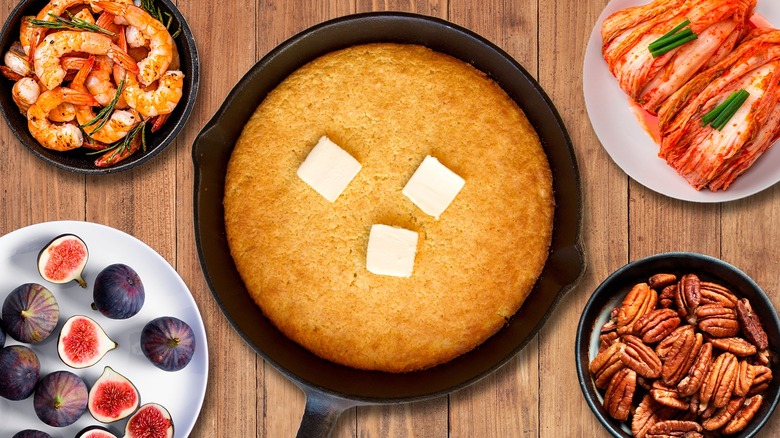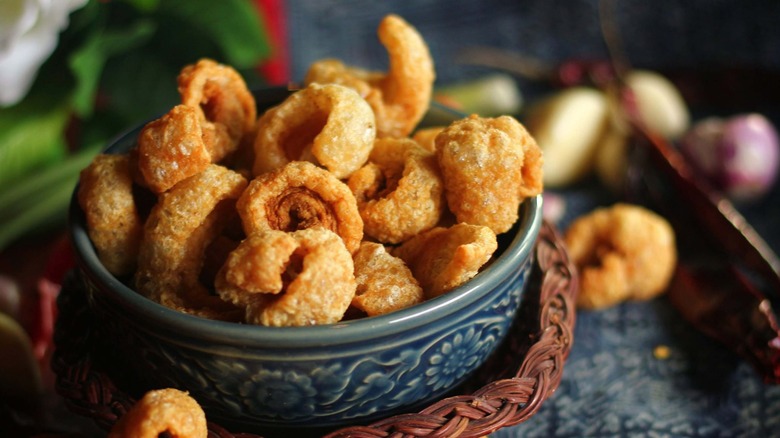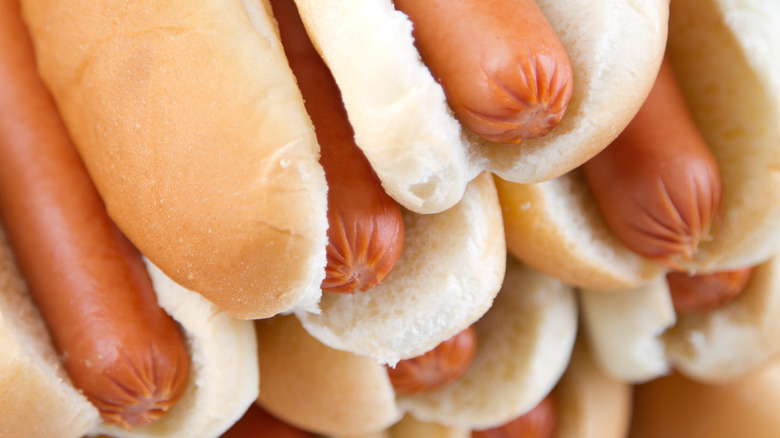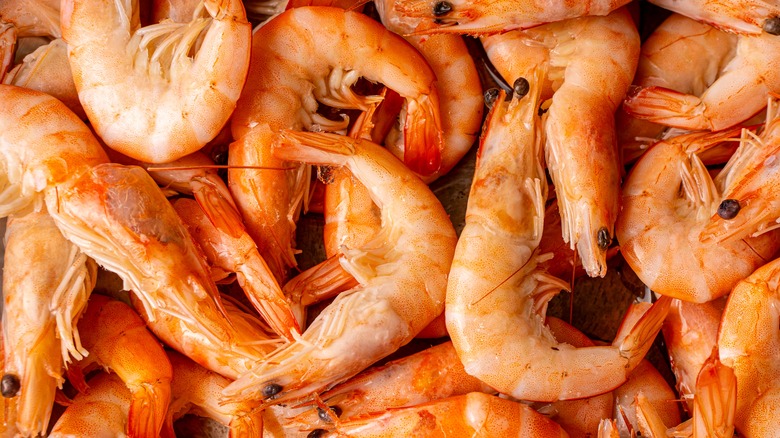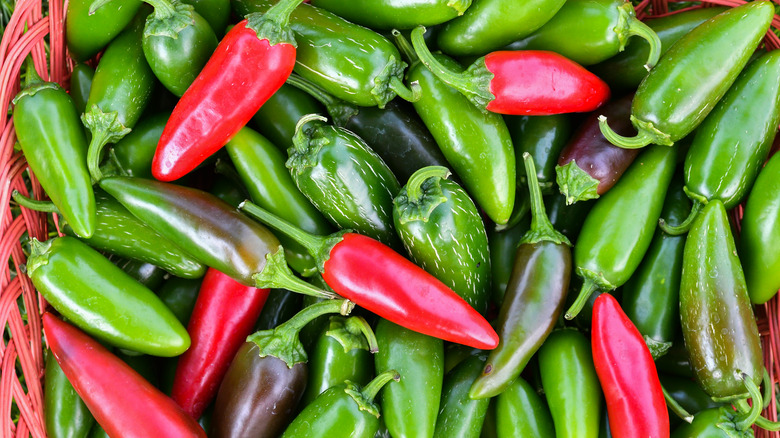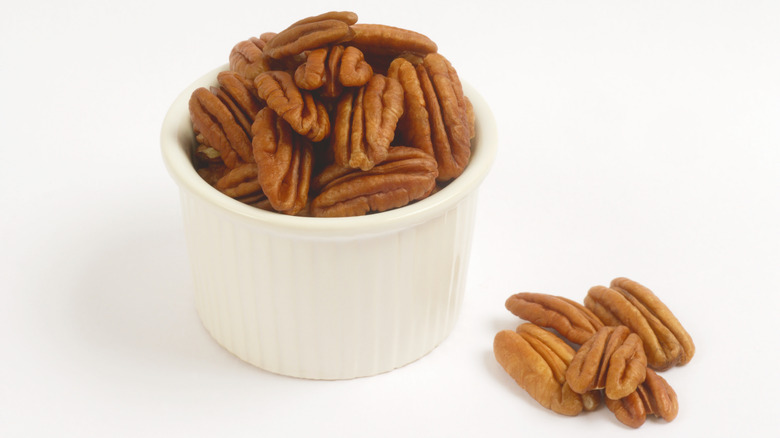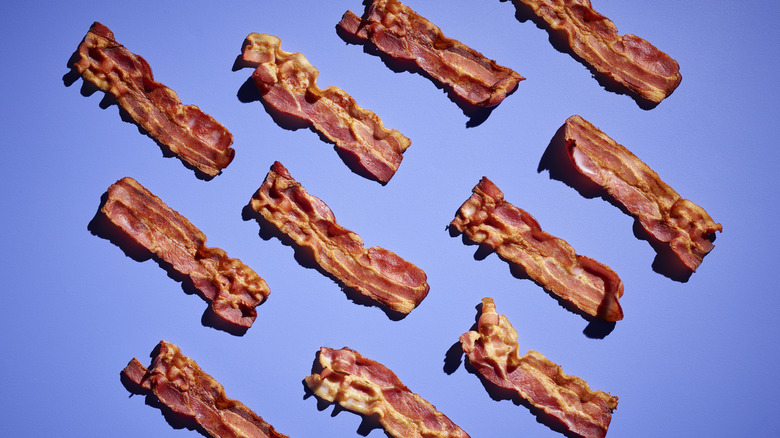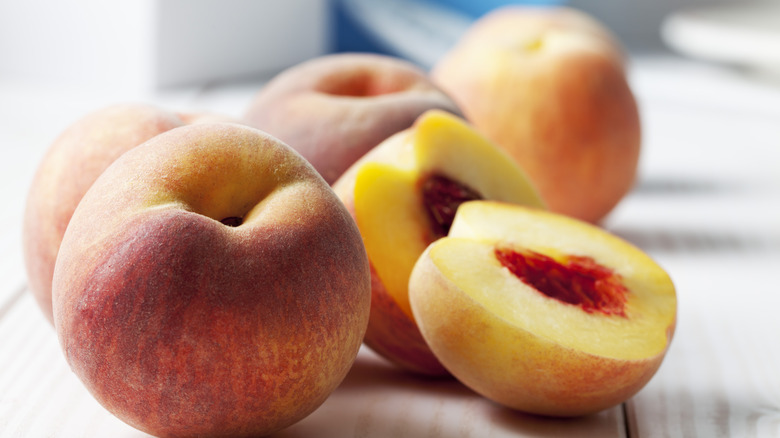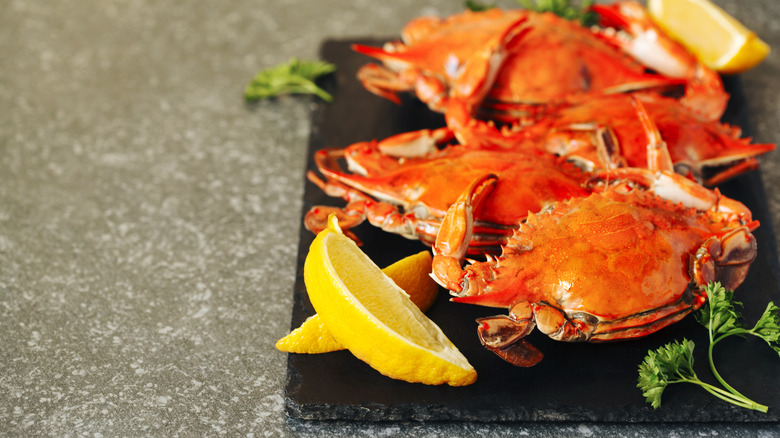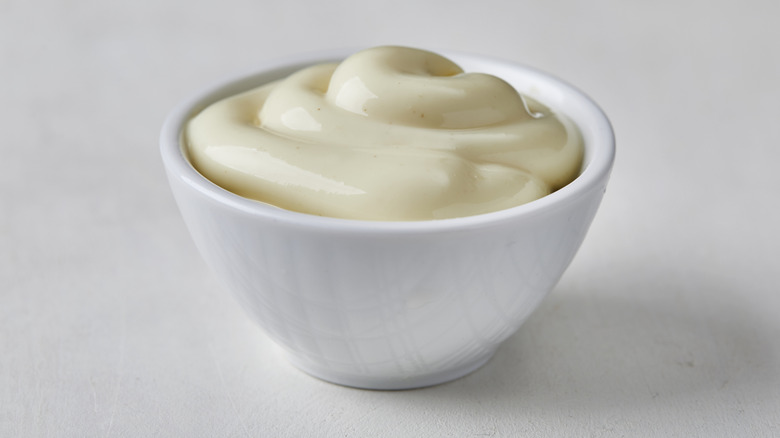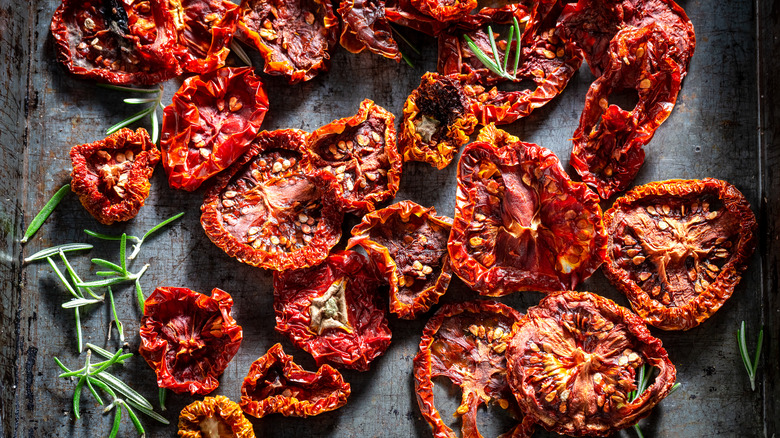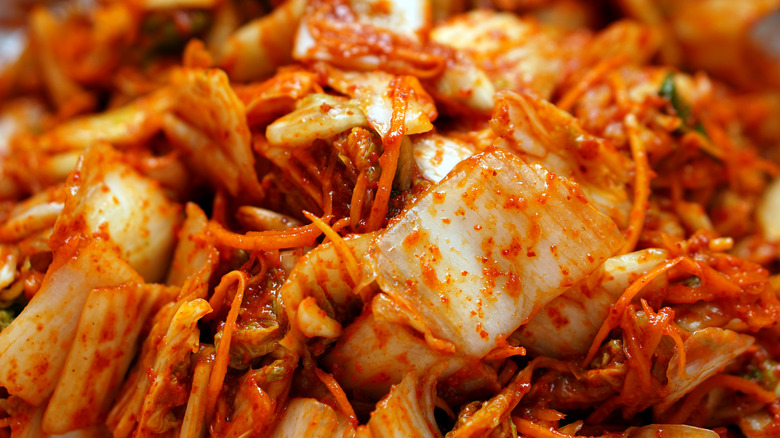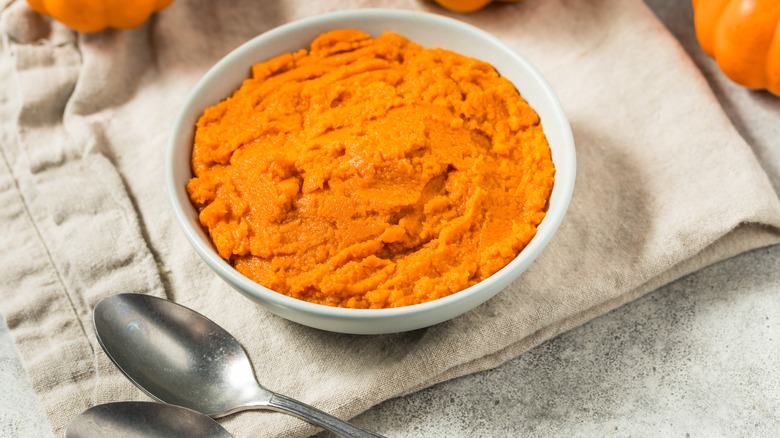14 Creative Ingredients You Should Be Adding To Cornbread
Let's face it, corn is quite possibly the most important crop to come out of the Americas. According to the United States Department of Agriculture, corn (also known as maize) accounts for "more than 95% of total feed grain production and use." It's used for feeding animals, people, and fueling cars, but for the American South, corn is best used to make some delectable sides, including cornbread.
A staple food in the Southern states, cornbread has been around for hundreds of years originally created by Native Americans using water, hand-ground cornmeal, and salt and cooked over a fire. Once European settlers arrived, they too began making their own version of cornbread as did enslaved peoples brought to the colonies. Additions of bacon grease, buttermilk, and salt pork elevated the flavor and allowed for the base recipe to be loved enough to be shared for generations. But one thing is for certain: Cornbread is as well-loved as other traditional Southern mainstays like fried chicken, sweet tea, and grits.
Today's cornbread recipes often depend on each household, with some in the North preferring sweeter cornbread to the more savory cornbread of the South. Regardless of preference, cornbread is an incredible conduit of flavors, especially when introducing some exciting — and perhaps unexpected — ingredients to the fold.
Pork rinds
Texture is everything when it comes to food, and while the crumbly foundations of cornbread are well-loved, the introduction of the light, airy crunch of pork rinds adds another dimension entirely. Pork rinds are the delicious aftermath of frying pig skin and are beloved down in Latin America under the name of chicharrónes. Most southern recipes for cornbread focus on creating a savory experience that forgoes sugar in the name of fat and salt so the addition of pork rinds leans into that for a salty, pork flavor in every bite.
One of the best parts of pork rinds are the ample flavor options. A regular run-of-the-mill pork rind will enhance cornbread's savory and salty flavor, but there are also barbecue, salt and vinegar, and butter-flavored pork rinds to ramp up the zesty or sweet factor, depending on your preference. Regardless of which flavor — if you choose one at all — pork rinds contrast beautifully with cornbread's hearty texture.
Hot dogs
The addition of hot dogs in cornbread is much the same as the idea behind corn dogs. After all, a corndog is quite literally a hot dog dipped in cornmeal batter (we know how America loves those). Perhaps the most wonderful addition that the meatiness of a hot dog adds to the rich cornbread flavor is the fact that hot dogs come in plenty of flavors. For the traditionalist, a beef or pork-based hot dog creates a wonderful meaty snap to balance the cornmeal base. Others can opt for vegetarian hot dogs or even infused hot dogs — think those stuffed with bacon, cheese, or other veggies for maximum flavor. Not to mention the different add-ins beyond hot dogs to make your cornbread recipe pop.
There are also endless options for how to pair hot dogs and cornbread together. Cutting up the pieces and mixing into batter is an option while putting hot dog pieces in muffin tins covered in batter creates on the go deliciousness.
Ranch
Ranch dressing makes everything better, including cornbread. It might sound strange given ranch's history — thank you to plumber Steve Henson for his invention — as many people's dip of choice, but the tangy, zesty flavor of ranch can go a long way to elevate any cornbread recipe. Perhaps ranch's greatest addition to cornbread is the unbelievable moisture it adds. As we all know, cornbread is crumbly by nature, and this is due to the fact that cornmeal (its primary ingredient) doesn't contain gluten. Gluten is what makes wheat-based products so sturdy, and without it, cornbread can have a tendency to, well, crumble.
Adding ranch dressing to cornbread adds another element of flavor but also alters the texture to something with greater bite and more fluffiness. This results in a slightly denser, bolder flavor profile and can be achieved with either store-bought or homemade ranch dressing (which can be achieved with just a few ingredients).
Shrimp
You've perhaps heard of shrimp and grits, but we raise you shrimp and cornbread. Simply put, shrimp has a special place in the heart of the coastal South and, when combined with corn bases, offers ample opportunities to experiment with amazing flavor combinations. As mentioned previously, cornbread has long been a conduit for the flavors and feelings of the people who make it, and the Creole people were just some of those who included seafood in their cornbread recipes.
It might sound odd to add seafood, but shrimp is the perfect pairing for cornbread because of its tender texture and mildly sweet brininess, which compliments cornbread whether mixed into the batter, sprinkled on top, or added between two layers of cornbread. The addition of other Creole seasonings, like cayenne, paprika, black pepper, and bay leaves, can turn a traditional cornbread into something new and different, like cornbread dressing or atop gumbo.
Peppers
Traditional cornbread doesn't always hit the flavor mark for some people, which makes the ingredients, like peppers, a delicious addition. With hundreds of varieties of pepper, there are options when it comes to spice level, sweetness, boldness, and bite. For Southerners, pimentos are the namesake ingredient in the always favorite pimento cheese dip and, as such, are great whether chopped or incorporated with cheese. That's because pimentos have a sweeter flavor and rank fairly low on the Scoville scale so are safe for those with milder taste buds.
On the other hand, jalapeños in cornbread offer a bold, slightly bitter taste and, when the seeds are included, add a manageable spice level. For an even greater depth of flavor, roasted jalapeños or pickled jalapeños bring a smoky or tangy moment to the party. From there, the options are rather endless in how spicy you can go. We certainly wouldn't recommend adding the Carolina Reaper or Pepper X (officially the hottest pepper in the world), but the skies the limit.
Pecans
Cornbread already evokes a homey feel, regardless of whether you grew up eating it or not. The addition of other comforting flavors only enhances the warm, feel-good feeling you get while eating it. Of course the mighty pecan already has ties to the South with the decadent and delicious pecan pie and pecan pralines.
As a staple of southern baking, it makes perfect sense to introduce pecans to cornbread. Added as a singular ingredient, the crunch of the pecan and nuttiness of its flavor imbue warmth and familiarity. To kick things up a notch (and give love to your sweet tooth) an addition of pecans alongside brown sugar, or some other sweetener, puts the resulting cornbread squarely in the dessert category due to its richness. As another homage to a favorite southern treat, consider adding extra butter to your cornbread batter or add it melted to the top of your finished cornbread for a riff on butter pecan.
Bacon
Back when cornbread was making its rounds among the southern United States population, people were looking for cheap, easy ways to liven their cornbread recipes without breaking the bank. One way they did so was by flavoring their cornbread batter with bacon grease or other forms of lard and also cooking the cornbread in that grease.
It creates a tenderness, moistness, and meaty flavor in the final product that can't be replicated with other ingredients. But another way to use bacon is to actually put pieces of it in the batter. Any type of bacon works, but the crispier, the better. This allows for the texture of the bacon to shine through in the cooked cornbread. Use thicker cut bacon if you want more texture, and consider using flavored bacon to bring out some of the underlying flavors in the cornbread. Maple chili, brown sugar, or hickory smoked black pepper are all great options for elevating the typical bacon cornbread mix.
Peaches
Cornbread is often seen as a side dish for lunches or dinners, but there are plenty of ways to sweeten cornbread for a breakfast debut. On its own, cornbread has a rather gentle flavor that can be paired nicely with different types of food like chili, barbecue, or jams and jellies. That makes it a great option to pair with lively fruit flavors.
Stone fruits are sweet, fleshy, and often aromatic, and peaches especially shine as an ingredient in cornbread due to its slight tartness and floral aroma. When peach slices are mixed into the batter, the result is a golden, juicy bite that gives just enough sweetness without being overwhelming. It's reminiscent in many ways of peach cobbler, which has its own storied history in the South, especially if you add sugar or cinnamon. Regardless of whether you use canned peaches or fresh from the orchard, you can't go wrong adding fruit to your cornbread recipe.
Crab
Crab is a versatile ingredient across regions, especially when it comes to incorporating it into beloved dishes. Whether it is crab beignets, crab cakes, crab deviled eggs, or shrimp and crab gumbo, crab makes for a great addition to any recipe due to its flaky, delicate texture and briny, but mild, flavor. That makes it an especially delicious addition to cornbread because it doesn't overpower the base flavors of the cornbread, instead complementing the mild flavor of the corn with the gentle texture of the crab.
The cornbread and crab combination can be jazzed up with a number of flavors like the infamous Old Bay seasoning or with something more subtle like garlic and butter. It can also take a more Asian-inspired spin with soy sauce, sesame oil, or Creole seasoning. Regardless of how you season things, the addition of crab adds textural and flavor benefits that have to be tasted to be believed.
Mayo
Ensuring moistness in cornbread is quite possibly the most important part of a cornbread recipe. It's why buttermilk was originally added to the recipe. Beyond the flavor it added, the acidity of buttermilk activated the leavening agent in cornbread, creating a fluffier result that held its moisture better. As such, moisture has always been a key target for home bakers, and it's why something like mayonnaise makes a perfect choice for ensuring a tender flavor and texture.
Mayo is simply egg and oil, two ingredients that already significantly contribute to moisture in baked goods, and even a tablespoon of it added to cornbread gives a flavor punch. Not only is the finished product moister, but it also has a distinctly rich and tangy flavor profile that's subtle but hard to miss. It may sound strange, but mayo is an umami addition that's difficult to replicate otherwise and can take your cornbread game to the next level.
Sundried tomatoes
The addition of sundried tomatoes to recipes creates a fusion of sweetness and tartness that ignites your taste buds. While often used in Mediterranean dishes, it can also be a delightfully surprising addition to cornbread. It also creates a world where cornbread can pair with pasta dishes, which may not be the first choice for some home cooks.
There's no preferred option between dry-packed or homemade sundried tomatoes, but if you're using dry-pack, the trick is to ensure that you soak them well to ensure they plump up. It may sound counterintuitive, given that "dry" is in their name, but if you don't soak them, that may cause the final result to be too chewy or tough. If you opt for the jar route, those sundried tomatoes often come packed in olive oil, which has been infused with the flavors and makes a delightful garnish or ingredient to further punch up the flavor.
Kimchi
Fusion recipes are increasingly popular as cultures share their dishes and flavors with one another. It makes sense then that kimchi, one of the most culturally significant Korean exports, has the potential to work well with cornbread. Now, we understand any hesitance to try especially since not everyone likes fermented foods. But for those who are willing to try, know that the addition of kimchi to cornbread adds moisture (due to the fermentation) as well as a strong umami flavor. Depending on who made the kimchi, there can even be a subtle kick of spice.
Now, there are several ways to actually add kimchi to the recipe with one being a rough chop of your kimchi before adding it to the batter. Other options include using kimchi flavors without the actual fermented cabbage. This doesn't have the same textural impact but can be made more subtle depending on personal taste preferences.
Figs
The noble fig is a fruit that many wouldn't think to pair with cornbread, especially when peaches or berries are around and accessible. However, we've found that the texture and flavoring make figs a perfect fit for cornbread. Figs are notoriously sweet and floral in large part thanks to their nectar and high sugar content, which makes for a delicious bit of caramelization when they figs are cooked within the cornbread batter or atop it.
If there aren't fresh figs available (or if you don't like them fresh), then fig jam swirled throughout the batter also provides the same essence of sweetness and floral freshness as the whole fruit does. As with other fruits, a hint of honey also goes a long way in punching up the fig flavor, though if you are sensitive to sweets, we recommend leaving out any additional sweetener as the figs do a great job on their own.
Pumpkin
Pumpkin spice isn't just for your coffee. Autumnal flavors can be delicious year-round, especially when paired with something like cornbread. Not only does pumpkin puree have a gorgeous color, but its earthy, slightly nutty flavor can pair beautifully with a sweeter cornbread, especially with the addition of warm spices like nutmeg and cinnamon. On the other hand, pumpkin can also be a delicious savory flavor. Paired with spinach, feta, and almonds or pecans, you can turn your cornbread side into a full meal.
It also helps that pumpkin exceeds expectations when it comes to adding moisture to recipes. But be careful with how much pumpkin you add to your recipe, since too much can cause the cornbread to come out too dense or heavier on the pumpkin flavor than you want. Adding pumpkin to your cornbread is an exciting way to diversify your recipes and use up leftover canned goods.
